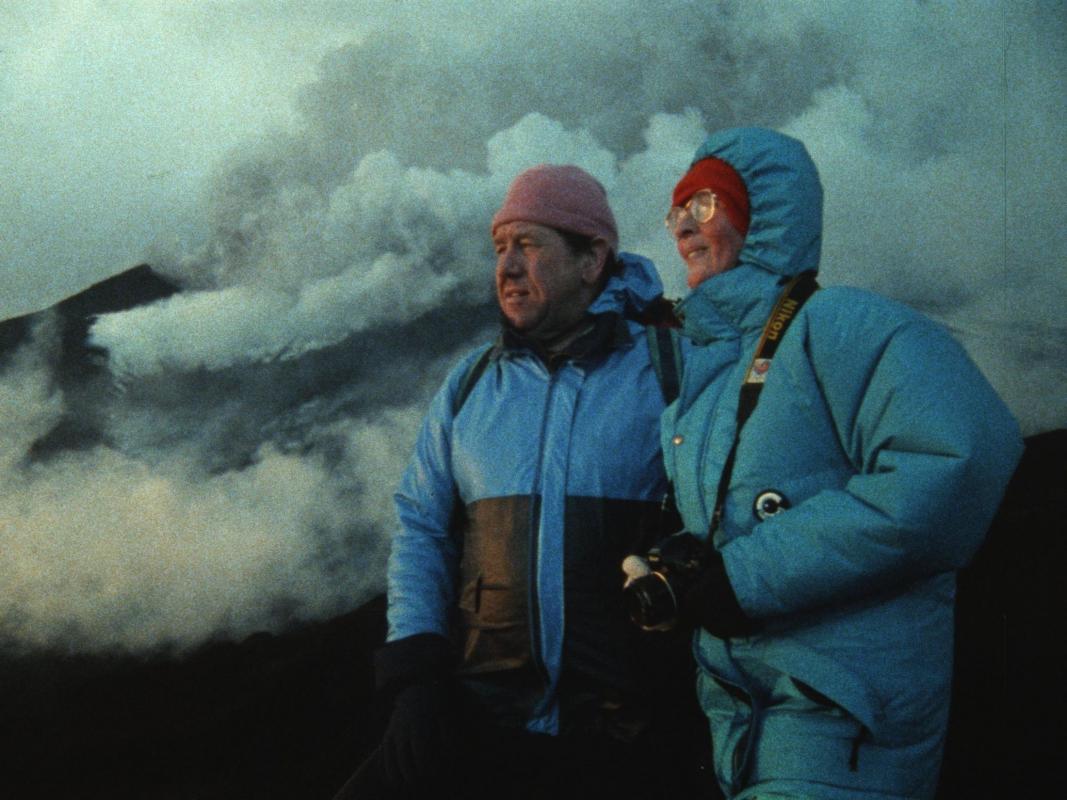
The Maryland Film Festival is back, in person, and so anxious to entertain you, it’s arriving a bit early this year—it starts April 27 and runs through May 1. There are many obvious highlights, including the traditional Opening Night Shorts, the annual “John Waters Presents” (this year, the Pope of Trash is sharing David Cronenberg’s criminally underseen Map to the Stars), and even a special screening of HBO’s We Own This City followed by a Q&A with some of its creators, including David Simon.
The closing night features two documentaries—Becoming Frederick Douglass and Harriet Tubman: Visions of Freedom—by the great Stanley Nelson, who will be there in person to discuss the films. In the meantime, be sure to peruse the entire schedule to see what catches your attention and even consider a festival pass. Here are reviews of four exciting titles to get you started. (I dig them all but fell hard for Fire of Love.)

FIRE OF LOVE
★★★★ (4 stars)
I’ve never been one to believe in soulmates—the notion that we each only have one person on earth that we are meant to spend our lives with—but the documentary Fire of Love, (pictured here and above) may have just changed my mind. It tells the story of French volcanologists Katia and Maurice Krafft, who fell in love, got married, and spent most of their waking hours studying and observing volcanoes. They had no children, because the volcanoes were their children. They lived sparsely, because the volcanoes were their home. The film is about two obsessives who found each other.
The Kraffts meticulously documented all of their expeditions, both on film and in diaries, because they largely made their living through books and movies. (As their renown grew, they became frequent guests on French talk shows.) Their excellent film footage—sometimes as artistic as it is scientific—makes up a large chunk of the film.
As rugged daredevils go, they were an unlikely pair. The tiny Katia, in particular, was mousy, sprite-like, with closely cropped hair, ruddy cheeks, and wire-rimmed glasses. Maurice was bigger—picture a cross between Christoph Waltz and Norm from Cheers—but still looked more like a bear-like intellectual than an adventurer. On their expeditions, they were both fond of wearing Steve Zissou-style red knit caps. (They did most of their volcanic research in the 1970s and ’80s.) Sometimes, to get closer to the volcanoes, they wore these tin-foil colored jumpsuits, with giant helmets that resembled something a mid-century spaceman would wear. The work they did was grueling and often impossibly dangerous, but they accepted the risks. They couldn’t imagine life any other way.
While Katia and Maurice were clearly the closest thing to soulmates I’ve ever encountered, they did have their differences. Katia was more mild-mannered, humble. Maurice was prone to self-mythologizing and bragging. Katia had more of the temperament of a scientist, whereas Maurice had more of the temperament of an explorer or adventurer. She was drawn to the volcanoes in spite the danger; he was drawn to them because of the danger.
Directed with care, curiosity, and insight by Sara Dosa, and exquisitely narrated by actress/filmmaker Miranda July, Fire of Love is a singular experience—part love story, part character study, and part nature film. The volcanoes, which are listed as “co-stars” of the film, are indeed awe-inspiring—gorgeous, immense, powerful, terrifying. I’ve never seen such remarkable footage of magma, lava, fire, and ash in my life.
But in the end, what lingers is the image of Katia and Maurice—standing side by side, staring into the abyss. Because they are together, they are unafraid. (Buy tickets here.)

NEPTUNE FROST
★★★ (3.5 stars)
The film Neptune Frost is best enjoyed as a thoroughly immersive experience. Set in Burundi, Africa in an indeterminate future, it’s a phantasmagoria of music, dance, costume, and poetry, unlike anything I’ve ever seen before. The plot isn’t necessarily its selling point, but the film clearly has lots on its mind, too. It’s mainly about systems of oppression—government, technology, military, even gender roles—and how it is within man’s ability to transcend such things.
The film has two main characters: One is Neptune, an intersex young wanderer—they start in a male body (Elvis “Bobo” Ngabo) but spend much of the film in a female one (Cheryl Isheja)—who flees their village after a priest attempts to molest them. The other is Matalusa (Bertrand “Kaya Free” Ninteretse), who experiences a life-altering tragedy while working in the sweltering heat on a gold mine.
Neptune Frost is created by the avant-garde rapper, actor, and poet Saul Williams and his partner, the actress and playwright Anisia Uzeyman. The music that Williams composes for the film combines elements of rap, African drum-beat, and African folk. Characters in the film sing, chant, rap, bang on drums, and stomp their feet, making it, at times, nearly impossible to sit still.
The costumes, as mentioned, are works of art unto themselves, combining wire, mesh, mirrors, jewel-tone fabrics, and even bicycle rims. In their female form, Neptune mostly wears a sculptural red dress—evoking a kind of post-modern Little Red Riding Hood—and has a striking shaved head with two red braids cascading down their back.
In the film’s Afrofuturistic world, a group of refugees have gathered in a hidden enclave, where they attempt to hack into the motherboard of the oppressive The Authority. Theirs is a utopic life in some ways, albeit a nerve wracking one—they fear invasion from soldiers at any moment. Both Neptune and Matalusa eventually make their way to this hidden “kingdom.”
The paradox at the center of Neptune Frost is that the hackers need technology to conquer their oppressors, but they also believe mankind is oppressed by technology. The most important thing is not systems or “Google” or even anything you can contain in a book, the film argues, but the vibrant immediacy of poetry, dance, and love. (Buy tickets here.)

SIRENS
★★★ (3 stars)
A striking thing about Sirens is how well it lines up with other rock band documentaries I’ve seen. The bandmembers have lip piercings and tattoos and wear concert tees emblazoned with the names Judas Priest and Slayer. They travel to a festival in Europe where they play for a disappointingly sparse crowd. They rehearse. They fight. One bandmember quits. And eventually they realize that they’re best as a unit.
What makes Sirens different, though, is that they’re an all-female thrash metal band (called Slave to Sirens) from Beirut, Lebanon. They are performing against a backdrop of civil unrest and the threat of war, in an atmosphere rife with misogyny and homophobia. They use music to express themselves in a way that society won’t let them. It’s the ultimate outlet—a public and personal battle cry. (Tellingly, the bandmembers love to drop the F-bomb, in English. Their defiance is largely borrowed from Western models.)
Although the band has five members, the doc focuses mostly on the relationship between its somewhat withholding lead guitar player, Lilas, and its brilliant lead guitarist Shery. The relationship is never completely spelled out, but it seems that Shery is in love with Lilas—or at least holds on to lingering feelings for her—and they had a fling before Lilas had fully acknowledged her own sexuality. Lilas seems to resent Shery for this, or maybe she just doesn’t like being idolized, in general. Lilas comes across as the kind of person who likes to keep people at bay.
Lilas is a fascinating figure, straight out of a work of fiction. She has the kind of self-possession that makes her intriguing, if unattainable to the people in her life—her bandmates, her friends, even her own mother.
It’s quite funny when we see that Lilas’ day job is as an elementary school music teacher. She seems way too cool for school, as it were.
When the band performs, they are the real deal. This is not pseudo-heavy metal, toned down for gentle sensibilities. They rock—hard. At times, lead singer Maya Khairallah makes growling howls that are barely human. They will win over any audience that has truly come to bang their heads.
Sirens, which was directed by Rita Baghdadi and produced by the actresses Maya Rudolph and Natasha Lyonne, works best as a character study of Shery and Lilas, who are never less than compelling. But there are definitely things I wanted more of: For one, I wanted to see the band perform more! We really only get to see snippets of their shows and rehearsals. (Perhaps Baghdadi thought the music would give audience members a headache?) And I’d like to have gotten more of a sense of the obstacles they had to overcome to even create this band.
Early in the film, Lilas talks about the mean things people say about the band on the internet—they’re called everything from “sluts” to “whores” to “satanic.” But that’s not too different from, well, being any woman on the internet. Lilas also keeps her sexuality a secret from her family, but again, that’s not an uncommon struggle for a young LGBTQ person just getting to know herself. There are hints of the unrest: At one point, Lilas and Shery walk through a roiling protest against the government. It must be a common occurrence, as they barely seem to register it. At another, a bomb explodes somewhere in Beirut—but it’s not clear how it has affected the band directly, other than Lilas saying she doesn’t feel “safe” in her own city. We don’t see much in the way of government censorship or even pushback from their families.
Sirens is entertaining and enjoyable, a crowd-pleaser. I do wish it had dug deeper, but I’ll never turn down the opportunity to hang out with a bunch of badass young women who simply want to rock. (Buy tickets here.)

HIT THE ROAD
★★★ (3.5 stars)
In the Iranian family road trip dramedy Hit the Road, viewers find themselves trapped in a car with a 6 year old who is as cute as he is exasperating. He’s the floppy-haired “Little Brother” (Rayan Sarlak)—and he isn’t fond of sitting still. He squirms, he screams, he sings, he climbs all over his parents, he yammers on incessantly. But he’s a sweetheart, too, who adores all creatures big and small and admires the beauty of the rugged Iranian landscape so much that he has a habit of spontaneously kissing the ground in solemn appreciation. He’s stuck in the back seat of the car with his hilariously put-upon and droll father (Hasan Majuni), who is nursing a broken leg, which itches—he often instructs his son to scratch his feet with an antenna. In the passenger seat is the elegant family matriarch (Pantea Panahiha), who is trying to keep herself from crying.
You see, the sullen driver (Amin Simiar) is their eldest son and he is about to be illegally smuggled across the border, at great cost to the entire family, which seems to have sold off most of their possessions to make this journey happen. The oldest son warns his mother to keep herself together—if she breaks down, so will he. They keep the real reason for the trip from the little boy—he thinks his brother is off to be married to a beautiful woman (either that, or to go hang out with Batman). And there’s another secret they keep from the child: The dog they rescued at some point along the way has an infection and is dying.
Panah Panahi’s debut feature is remarkably assured—tender, funny, artfully shot, and wise (his father is the famous Iranian director Jafar Panahi). It’s a road trip, a story about the ways in which different family members express their love, and both a love letter to the beauty of Iran and a sometimes absurdist condemnation of its current political climate. Life goes on, the film seems to say. You let your oldest son go take on a dangerous and uncertain world, your dog gets sick, but you still have a six-year-old in the back seat, singing at the top of his lungs. (Buy tickets here.)
